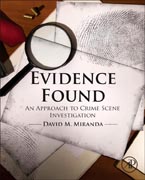
Evidence Found: An Approach to Crime Scene Investigation examines the thought processes that can lead to forensic errors. It includes tips and tricks gleaned from the author's 25 years of relevant experience in the field. As both low and high profile crime scene investigations suffer from errors that lead to negative impacts on both investigation results and court proceedings, this text evaluates the decision-making process, including case studies and logical arguments that provide a framework readers can use to recognize, evaluate, and alter negative decision-making patterns, including self-examination, before they negatively impact an investigation or the overall operation of a forensic unit. Enhances the base concepts of evidence search and sequential processing for error avoidancePresents an evaluation of the types of errors that lead to negative impacts on both investigation results and court proceedings Examines the systemic areas/practices of a crime scene investigation where errors can occurProvides tips on overcoming common crime scene issues, including nighttime searches INDICE: Introduction - Developing a Forensic MindsetChapter 1: Evidence Search - Planning and intention Chapter 2: Evidence Search - Techniques, Tips and Tricks Chapter 3: Sequential Processing - Determining evidence valueChapter 4: Sequential Processing - An Evidence MatrixChapter 5: Sequential Processing - The crime scene briefingChapter 6: Evidence Processing - Decision making processChapter 7: The Schema of Criminal Investigations Chapter 8: The CSI Effect - A new approachChapter 9: Emergencies - Planning for, Responding to, CreatingChapter 10: Courtroom TechniquesChapter 11: Ongoing Challenges - NAS impactChapter 12: Miscellany - Do's and Don'ts Chapter 13: Final Thoughts
- ISBN: 978-0-12-802066-1
- Editorial: Academic Press
- Encuadernacion: Rústica
- Páginas: 206
- Fecha Publicación: 03/01/2015
- Nº Volúmenes: 1
- Idioma: Inglés
